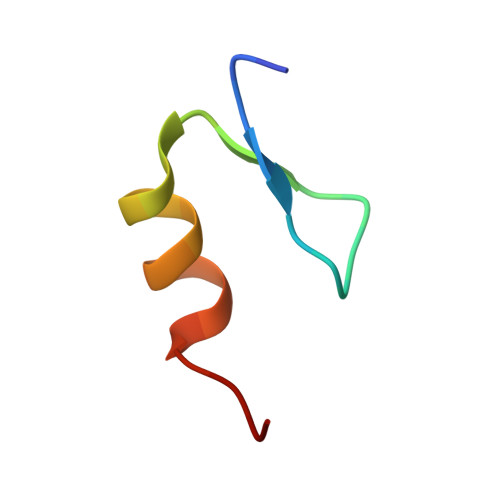Solution structure of NEMO zinc finger and impact of an anhidrotic ectodermal dysplasia with immunodeficiency-related point mutation.
Cordier, F., Vinolo, E., Veron, M., Delepierre, M., Agou, F.(2008) J Mol Biol 377: 1419-1432
- PubMed: 18313693
- DOI: https://doi.org/10.1016/j.jmb.2008.01.048
- Primary Citation of Related Structures:
2JVX, 2JVY - PubMed Abstract:
The regulatory NEMO (NF-kappaB essential modulator) protein has a crucial role in the canonical NF-kappaB signaling pathway notably involved in immune and inflammatory responses, apoptosis and oncogenesis. The regulatory domain is located in the C-terminal half of NEMO and contains a classical CCHC-type zinc finger (ZF). We have investigated the structural and functional effects of a cysteine to phenylalanine point mutation (C417F) in the ZF motif, identified in patients with anhidrotic ectodermal dysplasia with immunodeficiency. The solution structures of the wild type and mutant ZF were determined by NMR. Remarkably, the mutant adopts a global betabetaalpha fold similar to that of the wild type and retains thermodynamic stability, i.e., the ability to bind zinc with a native-like affinity, although the last zinc-chelating residue is missing. However, the mutation induces enhanced dynamics in the motif and leads to an important loss of stability. A detailed analysis of the wild type solution structure and experimental evidences led to the identification of two possible protein-binding surfaces that are largely destabilized in the mutant. This is sufficient to alter NEMO function, since functional complementation assays using NEMO-deficient pre-B and T lymphocytes show that full-length C417F pathogenic NEMO leads to a partial to strong defect in LPS, IL-1beta and TNF-alpha-induced NF-kappaB activation, respectively, as compared to wild type NEMO. Altogether, these results shed light onto the role of NEMO ZF as a protein-binding motif and show that a precise structural integrity of the ZF should be preserved to lead to a functional protein-recognition motif triggering full NF-kappaB activation.
Organizational Affiliation:
Institut Pasteur, Unité de RMN des Biomolécules; CNRS, URA 2185, F-75015 Paris, France. fcordier@pasteur.fr















